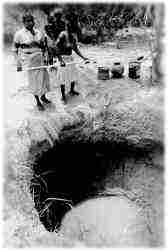The Taoists used to say, "A nation that pollutes its own river is a dead nation" and unfortunately that's what we are going to face if all governments don't take urgent measures. The word Water, in Franco-Provençal and Provençal has an important name: Eve. Most of the earth's waters are to be found in the oceans, seas and salt lakes.
Fresh water accounts for scarcely 3% of the planet's waters but 79% of it is trapped in the polar icecaps and 20% is hidden in subterranean waters. Of the remaining 1%, half is contained in living organisms, damp soil and in the atmosphere. Lakes and rivers make up for only 0.5%. Every year 500,000 cubic km of water evaporate from the earth's surface of which 430,000 cubic km from the oceans and 70,000 cubic km from the land.
390,000 cubic km return to the oceans and 110,000 cubic km to the land. This means that the land gains a total of 40,000 cubic km a year. Of these 110,000 cubic km around 14,000 could potentially be used for human consumption (agriculture, industry, domestic use). But 5,000 cubic km are not directly available and of the remaining 9,000 cubic km the forecast for the year 2000 is of 5,200 cubic km a year. Therefore, water is a limited resource because of questions of time balances in the water cycle.

A tipical African well in central Mozambique
(photo Blue Planet©)
Around 45,000 cubic km of water ends up deeply trapped in the earth's surface. But, apart from the difficulties regarding access to this reserve, thousands of years are needed to reintegrate it. To draw on it would mean breaking a delicate equilibrium, also on the earth's surface. In agriculture, only 270 million hectares out of a total of 1,400 million are actually irrigated, corresponding to around 20%. Annual growth is 1% but to cover the world's food needs irrigation would have to increase to 2.25% a year.
Around 3,400 cubic km a year of water is used in irrigation, industry consumes 650 cubic km a year and domestic use accounts for 270 cubic km. Average daily consumption for domestic use per person totals 700 litres in the USA and 170-250 litres in Europe. The African bushmen use 12 litres. Water for producing electricity is around 3% in Europe and 2% at a world level.
To produce 1 ton of beet you need 1,000 litres of water, 1,500 litres are needed for a ton of wheat, 4,000 litres for a ton of rice, while a ton of steel consumes 100,000 litres of water, the same as a ton of fabric or paper. The average tree needs 60,000 litres of water in order to increase its weight by 20 kg. 450,000 litres of water are needed to produce a car, 9 litres are needed to print a newspaper and 10 litres for a can of tomatoes. Instead, a kilo of bread contains half a litre of water.
Water has also become a handy means for transporting our refuse but this is a terrible mistake. A lot of waste which belongs to the earth cycle finishes up in water which cannot degrade it properly without damaging the delicate equilibriums. Therefore, besides the supply problem there is also a serious pollution problem, not to mention territorial instability and important climatic changes. Is it right to "produce" 250 litres of drinking water per person a day if the average consumption is two?
Is it right to "produce" 250 litres of drinking water per person a day if the average consumption is two? In Europe, purifying costs per person range from 300 to 1,800 US dollars a year. It is calculated that investment costs for the safeguarding and correct use of water would equal those of subsequent intervention. Therefore, water management is a question of measure.
(Taken from the Energy Dossier of the Val d'Aosta Region, Italy)
